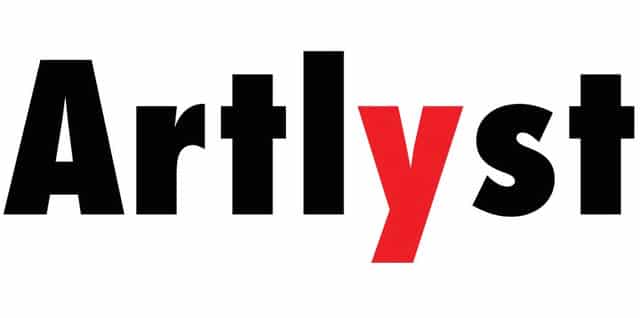We review the January exhibitions at London’s Zabludowicz Collection
Currently showing at the Zabludowicz Collection is ‘Future Map’ – a survey of the best talent to graduate from the University of the Arts London’s six colleges – and ‘Zabludowicz Collection Invites… Benedict Drew’ – a new initiative where the collection selects a young, currently un-represented UK-based artist, and gives them a platform to exhibit, and produce new work.
First to Future Map. The 33 works selected for this exhibition have been carefully organized, overcoming the fragmentation so common to group exhibitions on this scale. The first thing you notice on entrance is a spindly cuboid frame made of blue steel that encases the space just in front of the entrance door, as well as linking the ground floor to the gallery. This is by Nathan Murphy (Wimbledon MA Fine Art), and another of his steel shapes awaits you later as you leave the main hall, establishing a recurring motif that ties the spaces together.
In the main exhibition space, stand-out pieces include: Karin Soderquist’s (Camberwell BA Illustration) charming wooden tableaus entitled ‘To The North Pole’, in which explorers meet a grizzly (but warm) end inside a polar bear, all in ‘Pingu’-style technicolour; and the fantastic photographic work of Camilo Echeverri (LCF, MA Fashion Photography), depicting familiar student situations – the late-night weekly shop at Sainsbury’s, hanging on the telephone while the tiny fridge spills out onto the floor, staring into space in the local diner etc – each intricately styled and art directed. Look out, also, for Iyvone Khoo’s hidden-away video projection, which cleverly edits sound with ink drops in water, rotated and overlaid, to create a quite surreal end result.
Every one of these chosen artists and designers deserves a place in this selective showcase. But rush through it too fast, and you are in danger of feeling that this is yet another graduate show (albeit of a smaller college). This exhibition needs time above all else, with viewers necessarily querying the credentials of each piece. One worries especially for the designers in this exhibition, with many of the works on display simply not saleable in the mainstream of their chosen disciplines. University of the Arts are famous for producing the most ‘out-there’ creators, but this doesn’t always help graduates when it comes to producing and selling in the wider, more conservative world (there are of course exceptions, mainly within Fine Art and Women’s Fashion); however, one hopes, many of the Future Map exhibitors will surely progress some way thanks to this show – perhaps even helping to radicalize the mainstream in the long-term.
Great fashion design is represented by Jing Jing Cao, with a luxuriously intricate Elizabethan ruff, and Lulu Liu with two sumptuous fur capes. And there is remarkably skilled photography on show by Nicol Vizioli (LCF, MA Fashion Photography, again) – two dark and broody portraits, one a very convincing Miss Haversham (could beat the BBC’s Gillian Anderson’s hands-down), the other an androgynous figure clutching a fluffy rabbit to their breast.
Future Map this year also showcases a host of entrepreneurial product designers: Chieh Ting Huang’s (Camberwell, MA Visual Arts) striking lamps, evoking hot air balloons or lighthouses, and emitting subtle light through paper, like eastern lanterns; Jy Yeon Suh’s inflating, multi-purpose stools; and the prize-winner Wei Wang (LCF, MA Fashion Artefact), whose ceramic clutch bags are pure perfection. So beautiful to look at, they are also functional, each with carefully considered handles and clips to close them, and an array of different glazes, some cracked, some rubbed away, and some with an uninterrupted gloss finish. A well-deserved winner.
Benedict Drew (b. 1977, Kyneton, Australia) is another winner, but of a more special sort – as the first artist in the new initiative ‘Zabludowicz Collection Invites…’, in which the collection gives a young, UK-based artist the chance to present their work in the gallery. Drew engages with the theme of technology in contemporary life – both our reliance, and, equally, our abhorrence of it. The installation is disconcerting at first, but – upon grabbing a pew, and taking your place amongst the rows of cartoon eyes on flat screens, each gazing up at the main projection – you quickly become immersed. The piece intermingles text-art, CGI animation and tricks of the light to cunningly circumvent the problems of exhibiting this sort of contemporary, conceptual ‘tech-art’, not to mention, within a constricting space, and Drew has stepped up to the mark to justify his place as the first artist in this exciting new venture.
First there are spasmodic flickering lights, like a light bulb fusing, and projected onto the back wall are visuals evoking scenes from the Big Brother title sequence. Close-ups of eyes and camera lenses then turn to billowing artificial smoke, which becomes an engrossing sequence of low-fi animations, like, say, 1960s Dr. Who set design. And this is where Drew triumphs. These sorts of visuals – that were groundbreaking when they first appeared (remember when your screensaver looked like the view from a spaceship travelling faster than the speed of light?) – have now become the objects of our nostalgia. Now that we have now advanced far beyond many of the fantasies of early ‘science-fiction’, we hanker after that Land before Time – for the comfort and familiarity of clunky, basic machines. Words: Alice Lubbock / Photos: Thomas Keane © 2011 ArtLyst


